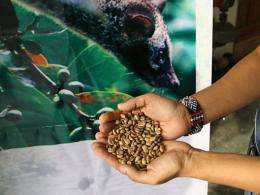Gene sleuths uncover the secrets of the civet

The Asian palm civet, a small nocturnal carnivore famous for excreting coffee beans prized by gourmets, in fact comprises three species, French scientists said on Wednesday.
Instead of one species, until now known as Paradoxurus hermaphroditus, there should be three, according to molecular biologists at the Museum of National History in Paris.
The species have developed separately in different habitats -- northeastern India; Southeast Asia, including Indonesia; and parts of Borneo and the Philippines.
Tree-loving and fruit-eating, palm civets are arguably best known for a smooth-tasting Indonesian coffee known as Kopi Luwak.
Its beans come from the ripest fruits eaten by the civet, which are claimed to pass through its digestive tract unscathed, enhanced by enzymes.
Retrieved from the faeces, the beans are roasted before being sold for up to 500 dollars per kilogramme (227 dollars per pound). Only 200 kilos (440 pounds) of the coffee are produced each year.
(c) 2010 AFP














